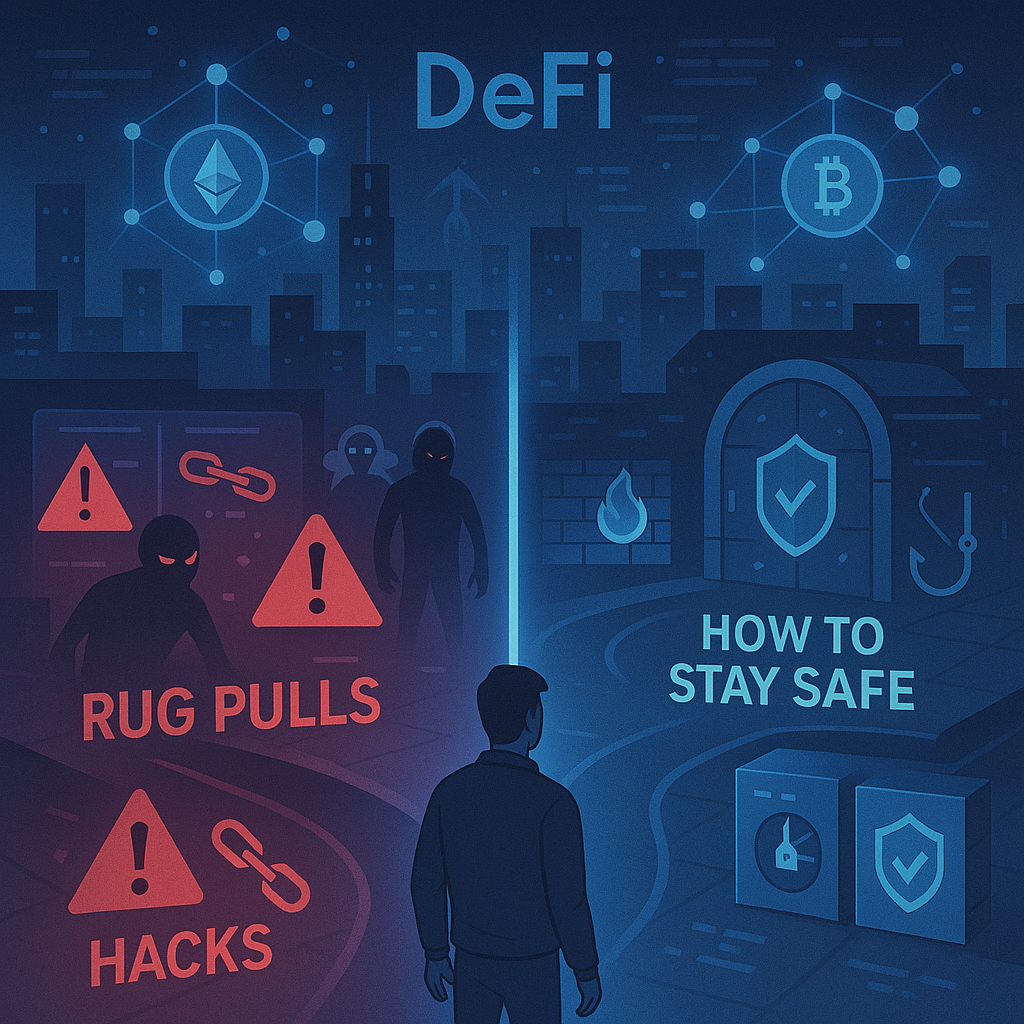Decentralized Finance (DeFi) is changing how we deal with money. It offers freedom from banks and gives people more control over their assets. DeFi opens up exciting financial possibilities, but it also brings its own dangers. Let’s look at the most common risks in DeFi and how you can stay safe.
What is DeFi ?
DeFi, which stands for Decentralized Finance, has a growing impact on the crypto scene. DeFi platforms don’t depend on regular banks or money companies. Instead, they operate on blockchain technology—typically Ethereum. These platforms apply smart contracts (code that runs by itself) to offer ways to lend, borrow, trade, and earn interest—all without middlemen.
This sounds impressive—and it is—but it also means users must take charge of their own money and safety.
Common Risks in DeFi
1. Rug Pulls: When Creators Disappear
A rug pull is a common scam in DeFi. It happens this way: Developers start a new project or token, hype it up, and convince people to invest. When the value increases, the creators withdraw all the money and vanish—leaving investors with tokens that have no value.
How to avoid it:
- Stay away from projects with unknown or unverified teams.
- Be careful of claims about big quick profits.
- Check for audited smart contracts and long-term project plans.
2. Smart Contract Bugs and Hacks
Because DeFi operates on code, any flaw in that code has the potential to be exploited. Hackers search for gaps in smart contracts to siphon money from DeFi protocols. Once criminals steal funds on-chain, users have a way to get them back.
Protection tips:
- Choose platforms that have undergone security audits.
- Seek out open-source code with a thriving development community.
- Avoid being the first to test new platforms—wait to see how well they protect users.
3. Phishing and Fake Platforms
Scammers don’t always use code to attack. They often set up fake websites social media accounts, or messaging apps to fool users into giving away sensitive information such as their private keys or wallet login details. Once scammers gain access, they can drain your wallet .
To protect yourself:
- Never give out your wallet’s seed phrase.
- Always verify website addresses before linking your wallet.
- Use official links from reliable sources.
4. Flash Loan Exploits
Flash loans are a unique DeFi tool that allow users to borrow large sums right away and pay them back in the same transaction. While groundbreaking, these tools have also become a weapon for attackers. Flash loan exploits often involve changing token prices to get unfair profits or empty liquidity pools.
Best defense: Use DeFi platforms that have put flash loan protection mechanisms in place in their smart contracts.
How to Keep Yourself Safe in DeFi
1. Look Into Everything Carefully
Before you put money into any project, check it out. Read the whitepaper, look at the team’s background, see what the community says, and make sure the code has been checked by experts.
2. Use Trusted Protocols
Go for DeFi platforms that have earned trust and shown good results over time. Some examples are:
- Uniswap
- Aave
- MakerDAO These platforms have gone through tough security tests and gained the trust of users.
3. Spread Your Assets Around
Spread out your investments. Putting all your crypto in one DeFi platform—a new or little-known one—can be dangerous. Split your assets among several trusted platforms to lower your risk of losing everything.
4. Keep Your Wallet Safe
- Use a hardware wallet to get better protection.
- Turn on 2FA (two-factor authentication) wherever you can.
- Don’t click links from sources you don’t know or connect to dApps that look fishy.
